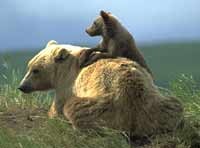
Way of the Bear in Alaska 1996
Distributed by Bullfrog Films, PO Box 149, Oley, PA 19547; 800-543-FROG (3764)
Produced by Daniel Zatz
Director n/a
VHS, color, 33 min.
Jr. High - Adult
Environmental Studies, Science
Date Entered: 11/09/2018
Reviewed by Rebecca Graves, J. Otto Lottes Health Sciences Library, University of Missouri-ColumbiaThe open, viable wilderness of Alaska still supports whole ecosystems which include large predators such as the brown bear. More commonly know as grizzly bears, brown bears have suffered due to a misunderstanding between bears and humans. It is the point of Zatz's and biologist Derek Stonorov's work to change this to a mutual understanding so that brown bears and humans can live together.
Filmed over 6 years, the documentary follows several bears in the McNeil River State Sanctuary. Relationships between mothers and cubs as well as between individual or solitary bears are portrayed. While usually thought of as solitary, there is a hierarchy among the bears. Individuals negotiate within this community by communicating through vocalizations, touching, smelling, body posture, and watching. This is aptly seen in the footage from the McNeil River where the bears come to fish for salmon. Here it is quickly apparent who has higher rank by watching the bears interact and noting who gets the prime fishing spots as well as who makes way for whom.
Cubs stay with their mothers for 2 1/2 to 3 years. Like all youngsters, they spend much of their time in play. Even if there is only one cub, the mother will take the part of playmate as play is how the young bear learns to interact with other bears as well as to hunt and forage. Bears continue to play into their adulthood with only the very old not playing at all. Not all is fun and games however. Other adult bears can pose a serious threat to cubs which gives mothers reason to be extremely protective.
By understanding how bears communicate and socialize, people can share the same wilderness. Acting in ways which don't surprise bears, such as keeping a distance, signaling one's presence from a safe distance, stepping back to signal reluctance for aggression, allows hikers and others to peacefully and safely coexist.
Interesting and with spectacular cinematography, The Way of the Bear is suitable for 7th grade and up. Those showing the film to younger audiences should note that there is a scene where two cubs are killed by an older adult bear. Suitable for classes in the following: geography, history, social studies, and biology.